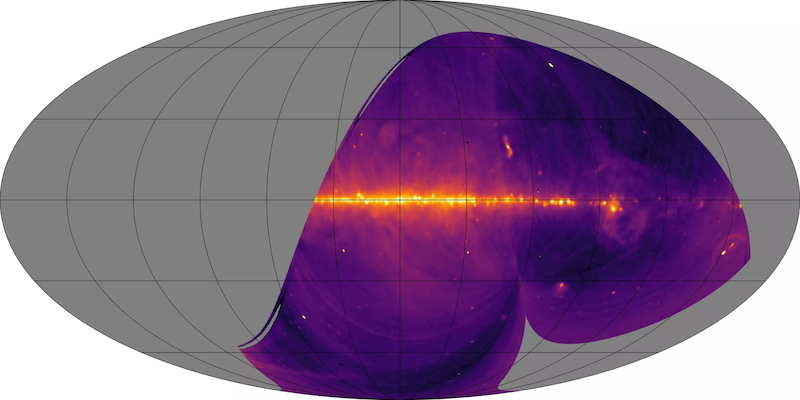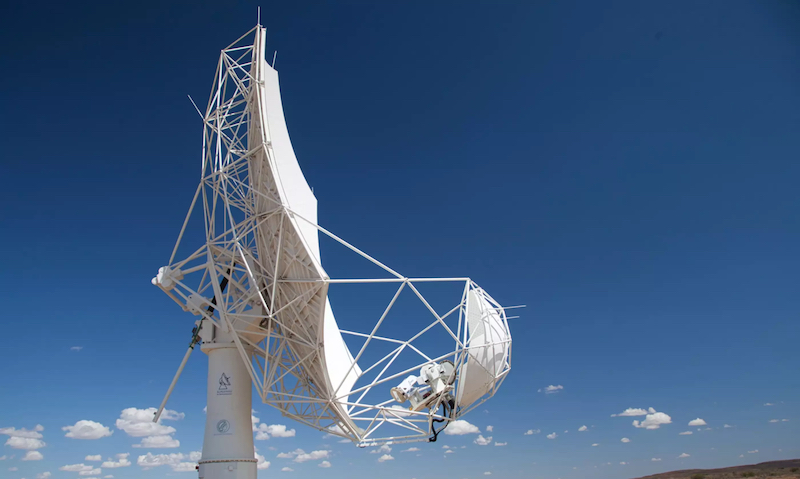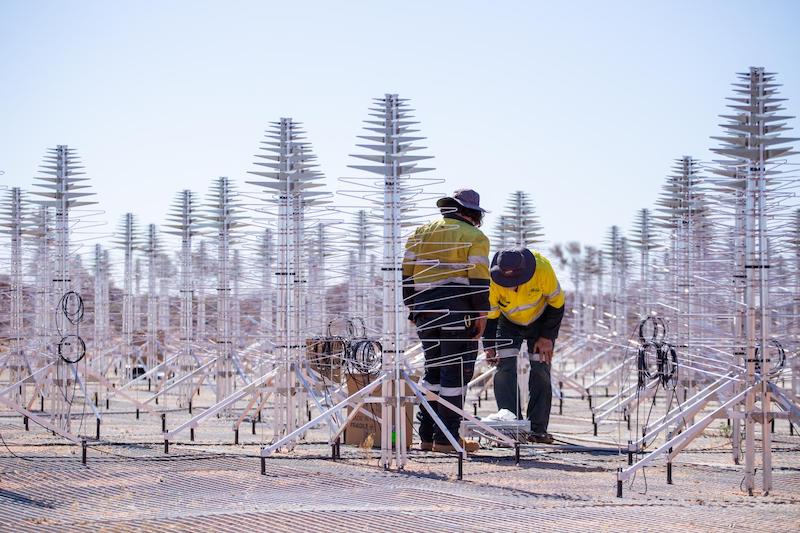
1st light for SKA telescope
Maybe you know that radio waves – at the far end of the electromagnetic spectrum – are longer than waves of visible light. That’s why radio astronomy benefits from very long baselines … long distances between coordinating antennas. The greater the distance between antennas, the more clearly the telescope can “see” in radio. Since the 1990s, astronomers have been picturing and planning an extremely big radio telescope, the biggest yet! SKA stands for Square Kilometre Array.
When its first stage is completed in the late 2020s, it’ll be the biggest radio observatory in the world. Its telescopes are to be located at two sites, one in Australia and one in South Africa (and, eventually, several other African countries). The South Africa site – called Karoo – will host 197 dish-type antennas. On January 25, 2023, the SKA Observatory reported that its prototype telescope at Karoo – called SKAMPI – achieved first light, with an image of the southern sky in radio.
And that’s real progress!
The uncalibrated image above shows radio emission from a sweep of the heavens including from the center of our home galaxy the Milky Way and the radio source at the Milky Way’s heart know as Sgr A (likely related to our galaxy’s central black hole), plus the bright radio galaxy Centaurus A, plus both of the Magellanic Clouds (large and small), and some Milky Way star-forming regions.
SKA’s South African prototype antenna – called SKAMPI (an acronym of Square Kilometre Array and the Max Planck Institute for Radio Astronomy) – is itself a radio telescope. On its own, it will learn of pulsars and radio emissions of our Milky Way galaxy. But that’s far from its only purpose. SKAMPI is a prototype for the 197-dish antenna array that will form the South African portion of the SKA Observatory.

First light = first image of a new instrument
A new astronomical instrument’s first use that results in an image is called first light. This concept is not as commonly given to radio telescopes, as their construction and first use is more incremental, unlike, for example, the Webb Space Telescope. The Webb’s first light image could not be measured until it had arrived to its final home in space. Also, a radio telescope observes in the radio segment of the electromagnetic spectrum, not optical light. But the only real difference is that radio waves are much longer than the wavelengths of light our eyes perceive. (And on that note, the Webb observes at infrared, just a bit longer wavelength than optical light).
Radio astronomy arrays get better resolution
In radio astronomy, combining many telescopes into an interferometric array, increases the resolution. In short, the larger the telescope, the better the resolution, but practical constraints make it impossible to build a single dish that large. The Chinese FAST is currently the world’s largest single-dish telescope at 500 m (1640 feet). An array has the resolution of a virtual telescope as large as the longest distance between the antennas. In the case of SKAO, this translates to one telescope dish 150 km (93 miles) in diameter, instead of the 15 m (50 feet) of each individual antenna.
Three decades of planning into fruition
The Square Kilometre Array idea was first conceived in the early 1990s. It evolved into an intergovernmental organisation in 2021 – the 2nd astronomical one after European Southern Observatory (ESO) – and currently consists of nine member countries. In December 2022, SKAO held groundbreaking ceremonies at both of its observatory sites and started the construction in earnest.
A first light image of the full observatory will likely be hard to pinpoint, as the antennas will start being used as they are constructed. But, if the science from precursor observatory MeerKAT, located at the same site, is an indication, we can likely expect some exceptional science to drop in as this radio facility keeps increasing in size. By the way, the 64 MeerKAT antennas will be incorporated into the final SKA, and SKAMPI is contributing to the development of the rest of the antennas.
Two sites with different antennas
Why build such a large observatory? What can we expect radio waves to reveal that we can’t see in, say, infrared with the Webb? The 197 antennas in South Africa, called the SKA-Mid, will observe from 350 MHz to 15.4 GHz in frequency. The Australian portion of the observatory, SKA-Low, will, as the name implies, observe at lower frequencies, from 50-350 MHz. Together, they will have a large collecting area, increasing the sensitivity by 10-100 times that of current observatories. The Australian telescopes are quite different in structure and looks. They are dipole antennas that mostly resemble Christmas trees and there will be roughly 130,000 of them, collected in 512 stations.

Science goals
In terms of science, this translates to being able to reach as far back as to the epoch of reionization, when stars and galaxies started forming. Only radio telescopes can measure neutral hydrogen far out in space, and, with the new ability to measure faint signals, can trace this building block of matter to before stars ionized the gas in the early universe.
And there are many more goals. The telescopes will better chart galaxy evolution, dark matter, and how the strength of dark energy has grown over time. They will monitor gravitational waves via observations of fluctuations in pulsar emission. SETI scientists will listen for faint signals indicating advanced life, while other exoplanet scientists will scrutinize birth of stars and planets.
Other mysteries we want to learn (much) more about include black holes and fast radio bursts. Not to forget more “local” astronomy where, for example, the telescopes trace neutral hydrogen gas in our own galaxy (there is a lot more to discover at home as well!). But maybe the most exciting discoveries to come are the ones we do not know about yet. They can be expected, because for every new instrument that comes into use, there have been surprises.
Bottom line: The SKAMPI prototype radio telescope has delivered its first light image of the southern sky. The telescope contributes to the development of a large 197-dish radio telescope in South Africa, as part of the Square Kilometre Array Observatory.











